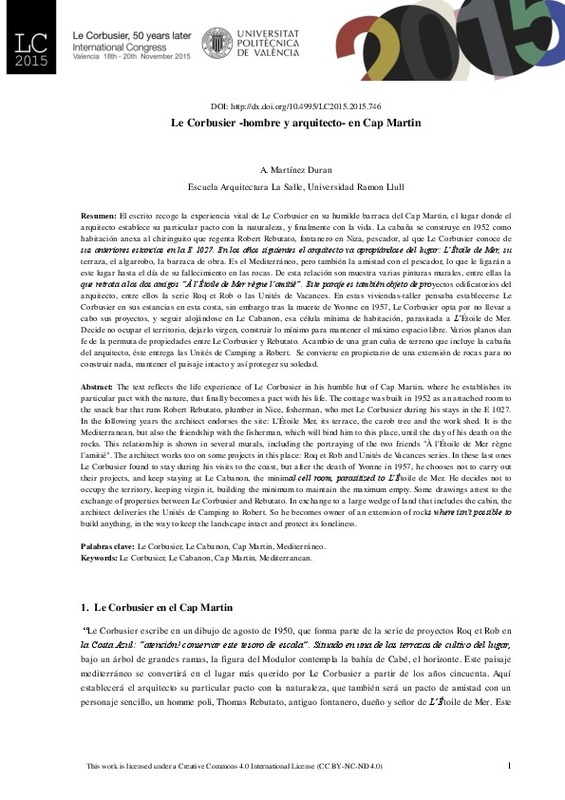JavaScript is disabled for your browser. Some features of this site may not work without it.
Buscar en RiuNet
Listar
Mi cuenta
Estadísticas
Ayuda RiuNet
Admin. UPV
Le Corbusier -hombre y arquitecto- en Cap Martin
Mostrar el registro sencillo del ítem
Ficheros en el ítem
| dc.contributor.author | Martínez Duran, Anna
|
es_ES |
| dc.date.accessioned | 2017-09-18T11:15:03Z | |
| dc.date.available | 2017-09-18T11:15:03Z | |
| dc.date.issued | 2016-03-03 | |
| dc.identifier.isbn | 9788490483732 | |
| dc.identifier.uri | http://hdl.handle.net/10251/87431 | |
| dc.description.abstract | [EN] The text reflects the life experience of Le Corbusier in his humble hut of Cap Martin, where he establishes its particular pact with the nature, that finally becomes a pact with his life. The cottage was built in 1952 as an attached room to the snack bar that runs Robert Rebutato, plumber in Nice, fisherman, who met Le Corbusier during his stays in the E 1027. In the following years the architect endorses the site: L'Étoile Mer, its terrace, the carob tree and the work shed. It is the Mediterranean, but also the friendship with the fisherman, which will bind him to this place, until the day of his death on the rocks. This relationship is shown in several murals, including the portraying of the two friends "À l'Étoile de Mer règne l'amitié". The architect works too on some projects in this place: Roq et Rob and Unités de Vacances series. In these last ones Le Corbusier found to stay during his visits to the coast, but after the death of Yvonne in 1957, he chooses not to carry out their projects, and keep staying at Le Cabanon, the minimal cell room, parasitized to L’Étoile de Mer. He decides not to occupy the territory, keeping virgin it, building the minimum to maintain the maximum empty. Some drawings attest to the exchange of properties between Le Corbusier and Rebutato. In exchange to a large wedge of land that includes the cabin, the architect deliveries the Unités de Camping to Robert. So he becomes owner of an extension of rocks where isn’t possible to build anything, in the way to keep the landscape intact and protect its loneliness. | es_ES |
| dc.description.abstract | [ES] El escrito recoge la experiencia vital de Le Corbusier en su humilde barraca del Cap Martin, el lugar donde el arquitecto establece su particular pacto con la naturaleza, y finalmente con la vida. La cabaña se construye en 1952 como habitación anexa al chiringuito que regenta Robert Rebutato, fontanero en Niza, pescador, al que Le Corbusier conoce de sus anteriores estancias en la E 1027. En los años siguientes el arquitecto va apropiándose del lugar: L’Étoile de Mer, su terraza, el algarrobo, la barraca de obra. Es el Mediterráneo, pero también la amistad con el pescador, lo que le ligarán a este lugar hasta el día de su fallecimiento en las rocas. De esta relación son muestra varias pinturas murales, entre ellas la que retrata a los dos amigos “À l’Étoile de Mer règne l’amitié”. Este paraje es también objeto de proyectos edificatorios del arquitecto, entre ellos la serie Roq et Rob o las Unités de Vacances. En estas viviendas-taller pensaba establecerse Le Corbusier en sus estancias en esta costa, sin embargo tras la muerte de Yvonne en 1957, Le Corbusier opta por no llevar a cabo sus proyectos, y seguir alojándose en Le Cabanon, esa célula mínima de habitación, parasitada a L’Étoile de Mer. Decide no ocupar el territorio, dejarlo virgen, construir lo mínimo para mantener el máximo espacio libre. Varios planos dan fe de la permuta de propiedades entre Le Corbusier y Rebutato. A cambio de una gran cuña de terreno que incluye la cabaña del arquitecto, éste entrega las Unités de Camping a Robert. Se convierte en propietario de una extensión de rocas para no construir nada, mantener el paisaje intacto y así proteger su soledad | es_ES |
| dc.format.extent | 14 | es_ES |
| dc.language | Español | es_ES |
| dc.publisher | Editorial Universitat Politècnica de València | es_ES |
| dc.relation.ispartof | LE CORBUSIER. 50 AÑOS DESPUÉS | es_ES |
| dc.rights | Reconocimiento - No comercial - Sin obra derivada (by-nc-nd) | es_ES |
| dc.subject | architecture | es_ES |
| dc.subject | le corbusier | es_ES |
| dc.subject | modern movement | es_ES |
| dc.title | Le Corbusier -hombre y arquitecto- en Cap Martin | es_ES |
| dc.type | Capítulo de libro | es_ES |
| dc.type | Comunicación en congreso | es_ES |
| dc.identifier.doi | 10.4995/LC2015.2015.746 | |
| dc.rights.accessRights | Abierto | es_ES |
| dc.description.bibliographicCitation | Martínez Duran, A. (2016). Le Corbusier -hombre y arquitecto- en Cap Martin. En LE CORBUSIER. 50 AÑOS DESPUÉS. Editorial Universitat Politècnica de València. 1364-1377. https://doi.org/10.4995/LC2015.2015.746 | es_ES |
| dc.description.accrualMethod | OCS | es_ES |
| dc.relation.conferencename | LC2015 - Le Corbusier, 50 years later | es_ES |
| dc.relation.conferencedate | November 18-20,2015 | es_ES |
| dc.relation.conferenceplace | Valencia, Spain | es_ES |
| dc.relation.publisherversion | http://ocs.editorial.upv.es/index.php/LC2015/LC2015/paper/view/746 | es_ES |
| dc.description.upvformatpinicio | 1364 | es_ES |
| dc.description.upvformatpfin | 1377 | es_ES |
| dc.type.version | info:eu-repo/semantics/publishedVersion | es_ES |
| dc.relation.pasarela | OCS\746 | es_ES |








